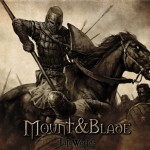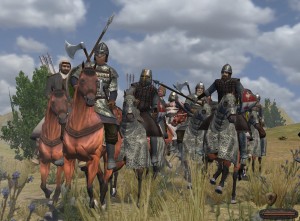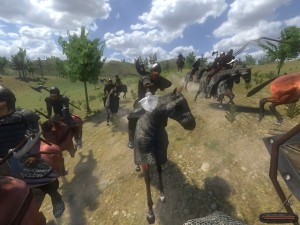 Originally created by Armagan Yavuz, founder of TaleWorlds, and his wife, ipek Yavuz, Mount and Blade could never be described as a polished or mainstream release. Initially available as a downloadable Beta, the full game was released in November 2008 into a market that had never quite seen anything like it. For all the new features that rival games layer on to differentiate themselves from the rest of their competitors, it’s the features that Mount and Blade leaves out that make it revolutionary.
Originally created by Armagan Yavuz, founder of TaleWorlds, and his wife, ipek Yavuz, Mount and Blade could never be described as a polished or mainstream release. Initially available as a downloadable Beta, the full game was released in November 2008 into a market that had never quite seen anything like it. For all the new features that rival games layer on to differentiate themselves from the rest of their competitors, it’s the features that Mount and Blade leaves out that make it revolutionary.
First of all there’s no real story. While games like Elder Scrolls and Dragon’s Age offer side quests as a diversion from an over-arching narrative, Mount and Blade has no such main story. Instead, the player is free to tell and experience their own story as they make alliances, build armies, fight battles, make friends and defeat enemies.
 While other fantasy games have dragons, wizards, magic and goblins, Mount and Blade sticks much closer to reality. Although based in far off lands with ridiculous fantasy names like “Calradia”, Mount and Blade could have been released as a medieval combat simulator. The weapons, armour and clothing all look believable and the lack of a story only adds to the authentic feel of the game. This is not a game where you’ll be “thwarting the vile orc warlord Gobthrax as he seeks to awaken the dreaded Night Dragon Lord”, and that’s to its credit. Rather, you’ll be moving through dirty villages full of dirty peasants and choosing your skills from character screens which I swear look dirty too.
While other fantasy games have dragons, wizards, magic and goblins, Mount and Blade sticks much closer to reality. Although based in far off lands with ridiculous fantasy names like “Calradia”, Mount and Blade could have been released as a medieval combat simulator. The weapons, armour and clothing all look believable and the lack of a story only adds to the authentic feel of the game. This is not a game where you’ll be “thwarting the vile orc warlord Gobthrax as he seeks to awaken the dreaded Night Dragon Lord”, and that’s to its credit. Rather, you’ll be moving through dirty villages full of dirty peasants and choosing your skills from character screens which I swear look dirty too.
Once the game begins there are no visual spectacles on display. Swords don’t produce colourful lightshows as they are swung, combo metres don’t climb and you won’t hear an announcer shout “ultra kill!”. You won’t see a cut scene showing your character preparing for battle and you won’t fight a giant end-of-level boss that throws fireballs for you to deflect with your shield.
With the game so lacking in genre tropes, it can be hard to explain to a newcomer exactly what the appeal of Mount and Blade is…until they play. Whether it’s the original, or the slightly better looking sequel “Warband”, the game doesn’t impress on first viewing. Poorly detailed NPC’s and a basic graphics engine conspire to undermine the game, and the basic presentation and cut-price feel of the interface will put many off. It’s not until the player takes to the battlefield for the first time and rides into combat that you get “the tingle”. It’s a feeling that incredibly rare in modern games; the feeling that you’re experiencing something new, something different from every other game you’ve played. And you like it.
As the name suggests a great deal of Mount and Blades focus is on riding into battle. Your horse is both a thematic and gameplay tool. It’s what differentiates you from the barbarian hordes that charge at you and it’s what gives you a chance of surviving against superior numbers. Kratos may have the Blades of Olympus, but in Mount and Blade all you have is your trusty steed to help you overcome your enemies.
Obviously your horse alone isn’t enough to win the day though. You ride into battles with a large range of different weapon choices. Most of the time you will have a melee weapon (usually sword) and a long range weapon (bow or crossbow). The strength of the combat comes from the unique, satisfying feel of these weapons.
There’s a real sense of simulation about combat. A horseman is a dangerous foe as he moves fast and can move through small groups of infantry easily. Striking downwards with their swords they rain down heavy blows on their enemies. Fighting on foot meanwhile (which is an option for the brave player) is stressful but exhilarating as a lone fast moving horseman can cut you down in a single pass. Combat places demands on the player for constant vigilance, and sometimes a fight with a tough opponent can be almost unbearably tense as a single blow can be decisive.
 Combat is controlled with movements of the mouse combined with button presses and it’s both intuitive and satisfyingly deep. Defensive blocks flow into heavy attacks in a way that seems to mimic real world sword fighting rather than swashbuckling movie duels. Most impressive of all, momentum plays a part in the damage of attacks. Hitting an opponent with a javelin is brutally effective, but if that javelin is also thrown from the back of a fast moving horse then the damage is much higher. This clever consideration of rudimentary battle physics is evident throughout the fighting system in Mount and Blade. You get a feeling that for all the time saved on visuals and presentation, no shortcuts were taken with the combat system. Whether it’s the specific rhythm and timing required to hit targets with the bows or the precise, controlled motion to swing the sword, there’s no combat system in any other game that feels quite the same.
Combat is controlled with movements of the mouse combined with button presses and it’s both intuitive and satisfyingly deep. Defensive blocks flow into heavy attacks in a way that seems to mimic real world sword fighting rather than swashbuckling movie duels. Most impressive of all, momentum plays a part in the damage of attacks. Hitting an opponent with a javelin is brutally effective, but if that javelin is also thrown from the back of a fast moving horse then the damage is much higher. This clever consideration of rudimentary battle physics is evident throughout the fighting system in Mount and Blade. You get a feeling that for all the time saved on visuals and presentation, no shortcuts were taken with the combat system. Whether it’s the specific rhythm and timing required to hit targets with the bows or the precise, controlled motion to swing the sword, there’s no combat system in any other game that feels quite the same.
Add to this the spectacle of large, pitted battles with many NPC’s and you start to see the kind of complex appeal that Mount and Blade holds. The graphics might be basic but the animation is fluid and the engine can show a great many enemies fighting on screen at once. It’s hard not to think of the best battle sequences from Braveheart or Lord of The Rings when the battles escalate in scope. Meanwhile if you are fighting the last enemy opponent on your own it can be hard to not shout out, “There can be only one!”
httpv://www.youtube.com/watch?v=x2GCwJdvDUI
It’s this tendency to write your own story that fills in the blanks left by Mount and Blade that appeals to me. Like many of the games I enjoyed growing up, there’s an element of blank-canvas that you can’t help but fill in. In classics like Moonstone or Sid Meier’s Pirates! the technology wasn’t available to craft fully voiced, immersive storyline and the result was your imagination filled in the blanks. When you no longer have to save a princess from a castle or free a kingdom (but can still choose to do so) the result is a game that’s emancipating. The downside of this is that it can leave the player failing aimless, but if the combat is satisfying like Mount and Blade’s, the player will keep playing long enough to craft their own goals and storylines.
Add to all of that the fact that Mount and Blade Warband added multiplayer support and you have a game that offers a lot for those willing to invest the time to coax out its unique charms. The upcoming “Mount & Blade: With Fire & Sword” may bring the production values and visuals up to a higher standard, but there’s no need to wait. For those who want something totally different from today’s mainstream releases, and perhaps hanker after some of the open ended nature of older RPG’s, Mount and Blade is the perfect antidote. Like sculpture, sometimes it’s what you take away, rather than what you add, that creates beauty.
